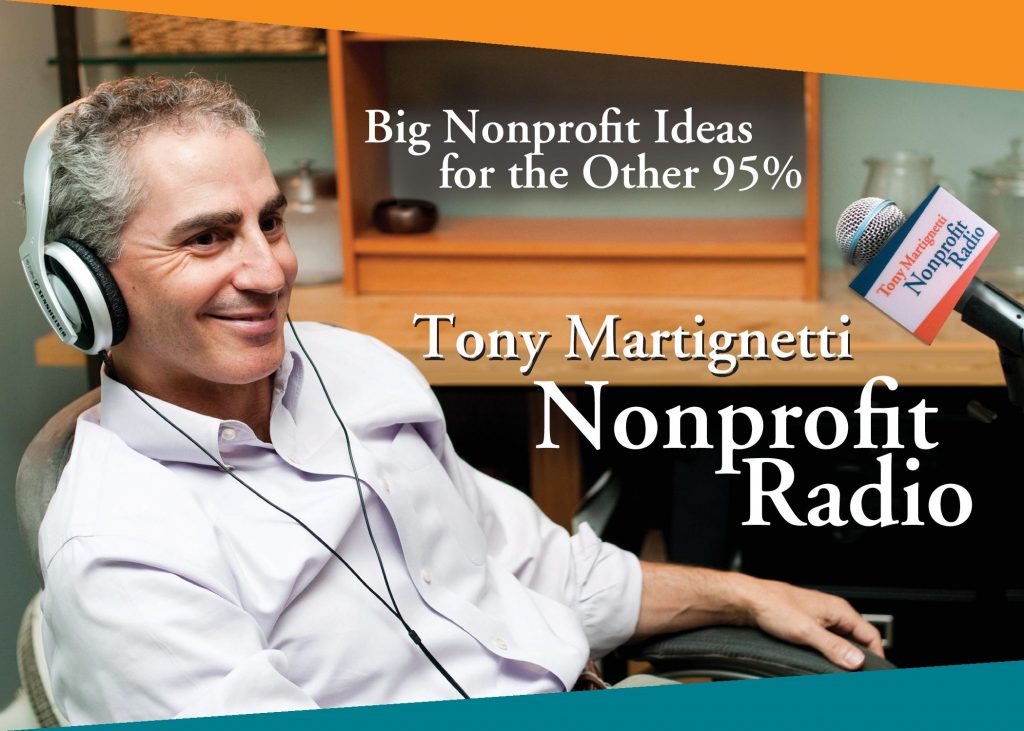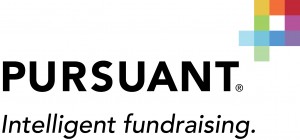Donor-centric doesn’t mean donor dominant. Ian MacQuillin shares his research and thinking on donor power structures in fundraising. For instance, let’s work at the sector, organizational and individual levels, to dismantle patriarchal structures. Ian is director of the Rogare fundraising think tank.
Board relations. Fundraising. Volunteer management. Prospect research. Legal compliance. Accounting. Finance. Investments. Donor relations. Public relations. Marketing. Technology. Social media.
Every nonprofit struggles with these issues. Big nonprofits hire experts. The other 95% listen to Tony Martignetti Nonprofit Radio. Trusted experts and leading thinkers join me each week to tackle the tough issues. If you have big dreams but a small budget, you have a home at Tony Martignetti Nonprofit Radio.
View Full Transcript
Transcript for 658_tony_martignetti_nonprofit_radio_20230918.mp3
Processed on: 2023-09-16T15:16:58.078Z
S3 bucket containing transcription results: transcript.results
Link to bucket: s3.console.aws.amazon.com/s3/buckets/transcript.results
Path to JSON: 2023…09…658_tony_martignetti_nonprofit_radio_20230918.mp3.650622323.json
Path to text: transcripts/2023/09/658_tony_martignetti_nonprofit_radio_20230918.txt
[00:00:38.40] spk_0:
Welcome to tony-martignetti Nonprofit radio. Big nonprofit ideas for the other 95%. I’m your aptly named host and the pod father of your favorite abdominal podcast. Oh, I am glad you’re with us. I’d be forced to endure the pain of black hairy tongue. If you made me speak the words you missed this week’s show. Associate producer, Kate. What’s coming up this week?
[00:01:10.26] spk_1:
Hey, tony, this week it’s donor dominance. Donor centric doesn’t mean donor dominant. Ian mcquillan shares his research and thinking on donor power structures in fundraising. For instance, let’s work at the sector, organizational and individual levels to dismantle patriarchal structures. Ian is director of the Rore fundraising think tank on Tony’s take two
[00:01:12.74] spk_0:
fourth quarter approach
[00:01:45.45] spk_1:
were sponsored by donor box, outdated donation forms blocking your supporters, generosity. Donor Boxx, fast, flexible and friendly fundraising forms for your nonprofit donor Boxx dot org and by Kila grow revenue, engage donors and increase efficiency with Kila. The fundraiser CRM visit Kila dot co to join the thousands of fundraisers using Kila to exceed their goals. Here is donor dominance.
[00:02:28.32] spk_0:
It’s a pleasure to welcome Ian mcquillan to nonprofit radio. He is director of the international fundraising think tank. Rore Rore aims to help fundraisers better use theory and evidence by translating academic ideas into professional practice and building fundraising’s knowledge base. Ian is recognized as a leading thinker on fundraising ethics. He’s at Ian mcquillan and the think tank, which he founded in 2014 is at Rore dot net from Portsmouth England, Ian. Welcome to nonprofit radio.
[00:02:32.00] spk_2:
Thank you very much for having me, um tony and the way you spelled out and read out a little bio biography about what Roa does. It makes me think maybe I need to change it and make it a bit punchier.
[00:02:42.57] spk_0:
Why I think it’s fine. Uh You, you think it’s why punch you, you think it sounds dull and boring it,
[00:02:47.64] spk_2:
get it, get, it, gets it across, but maybe we’ve had it for a while. Maybe it’s time to refresh the brand of the mission of it.
[00:04:14.95] spk_0:
Oh, all right. Well, brand refreshing. All right. I, I see. But I think, I think folks understand and they’ll understand better how you’re, you’re translating uh academia, academic thinking into professional practice as we uh have our discussion about uh donor dominance and uh donor power structures and how these impact fundraisers, how these impact, impact uh individual uh nonprofits, how they impact the sector wide. Um And what individuals, nonprofits and the sector can do to maybe may uh fight back. I don’t know, maybe that’s maybe fights. I, I hate to be in a uh like sound like an a AAA belligerent American. Everything’s a fight and everything is a competition but uh how we can um manage our donors so that uh these power structures maybe are, are become a more, a more level field for, for, for everyone, for the donors as well as for the, the fundraisers, the sectors of the sector and the uh the individual nonprofit. So I’m, I’m, I’m looking forward to a conversation about donor dominance. What I I what, what got you into this? Uh I know there were some incidents that brought you to the work, maybe uh maybe reveal some of those before we get into uh the substance and, and how it appears, it itself how it shows itself.
[00:07:36.26] spk_2:
Well, well, the one that really brought us to the idea of donor dominance, which is not a phrase that we have come up with donor dominance was used in an academic article way back in the early August in 2003. Uh And it, it is describing an imbalance of power where the donor can exhibit controlling behavior and that can lead to compromising the mission of an organization or its ability to serve its beneficiaries. So most fundraisers will be aware of the idea of mission creep where they maybe the donor tries to exert an, an influence over, over the mission to maybe follow the donor’s agenda or the ends or things that they want to do. So the idea that donors will have and can might have. This power is not new or unusual to fundraisers. And if you kind of just try and think about it from first principles, all relationships can be analyzed and thought of in some term of power differential or power dynamic. You know, when you think of a customer and a retailer, there’s a power dynamic there and one has more power than the other and sometimes that power shifts. So when it comes to charities and their fundraisers, who are their agents asking donors for money, the donor has something the charity wants, which is their wealth, their philanthropy, maybe their influence, uh all sorts of ways that they can support, not just money, um time and treasure and influence as well. And the donor doesn’t have to give that the donor can withhold that. So there’s that power imbalance already. The donor has some something that the charity wants and they have to ask for it and be nice to get it. So there’s not saying that it inevitably leads to any abuse of power, but there is the potential for the abuse of power. You can see that it is just there. Now people in all walks of life behave abominably all the time. People just behave badly. You see it everywhere in all walks of life, people are abusive to other people, they talk down to ST to staff, to people they believe are be beneath the they’re not nice to their friends and relatives. Um It’s not saying that all people don’t behave well. There are lots of saints, there are lots of angels, there are lots of people that don’t behave well. And I think it’s kind of slightly naive to expect that just because somebody is a donor and they’re doing a good thing for society and they’re expressing their philanthropy, that automatically means they will also be saints in the behavior in all of life. So there is, you can see whether donor dominance and bad behavior by donors actually does come to pass. It’s obvious that there is a potential for it. And the thing that really got us at RAA to think about the donor dominance issues was a case uh uh in the United Kingdom. Uh in 2018, I don’t know if you’re familiar or your readers will be listeners will be familiar with this. It was called the President’s Club dinner. And the President’s Club was this annual fund raising dinner where lots of the great and the good would get together for a big uh uh meal in a livery hall in London. And they would spend lots of money, pitch or auctions, raise loads. I mean, a hell of a lot of money at that.
[00:07:46.28] spk_0:
All of the great and good, mainly,
[00:09:34.03] spk_2:
mainly all men and you’ll see why you the bit that I’m coming to, which is completely, completely shocking that I’m coming to around this, um, they would then, like, grant that out to lots of charities. Now, a journalist for the Financial Times went undercover with the event company that was, um, providing the event, we staff for that event and the women were given a dress code which included the color and size of their underwear or a fundraising event. And of course she wrote and, you know, they were being, yeah. Yeah, they were being improperly touched. They were being, you know, slapped, they were using sexist misogynist language against them. Uh And this all came out in a complete scandal. The President’s Club, you know, lots of charities returned donations, refused donations. But it got us to thinking about why did no one know this was going on anyway, people must have been turning a blind eye to this practice. You know, it can’t have been that no one knew it was happening until a journalist went in and, and, you know, worked it out. What was going on. Why were, were people willingly turning a blind eye because they were getting money? Were they allowing their potential donors or arm’s length one removed because they were given to the residents club who were then given to the charity? But they were somehow facilitating um enabling this kind of behavior. And our chair is a uh a is the name I’m sure will be familiar to many uh us fundraisers, Heather Hill and this kind of relationship, um, abuse donor dominance was the thing that was really interesting. Her and she said to us, well, we, we’ve gotta, we’ve gotta look at this in more depth about the same time we were doing that. The chronic of, of philanthropy, uh, had also done its survey about, um, sexual abuse of female fundraisers and uncovered, I think the statistic was something like 25%. It may have been more, more than 75%. But, but a lot, you know, a significant number of female fundraisers that suffered sexual abuse and sexual harassment and a lot of that was apprehensive donors. So 20
[00:10:01.58] spk_0:
percent is, is interesting. II, I would, I would think that’s actually low if, if, if that’s the number the chronicle reported, I I suspect that there’s some, there’s some women who didn’t want to
[00:10:07.44] spk_2:
report it may have been higher. I may have got the 25% with the people that didn’t report it. So
[00:10:12.97] spk_0:
75 70 but
[00:10:22.72] spk_2:
it was a number that was causing concern because 25% is, you know, you say it’s probably low, but that’s, that’s a high number and even even 25. Yeah. And so you can, it was clear that there are some issues that needed to be dealt with and that’s what got us into looking at this issue of power imbalances donor dominance and are the relationships that we have with our donors or rather the the relationships they have with us always the appropriate ones and carried out appropriately.
[00:11:37.88] spk_0:
And you mentioned a few symptoms of this, uh, donors insisting on, uh, you called it mission creep, you know, insisting maybe on a new program. Uh I’ve seen it, uh, I, I saw it, I think the most extreme I’ve seen just anecdotally is uh, uh an all boys, uh, a Catholic school that was offered a very large gift to start admitting uh girls and, uh, and they acceded to that and I, I was not working with them. I was just aware of what was happening. They were not a client of mine. I had no relationship with them uh formally uh but they acceded to that. And II, I thought that was disappointing because it was not what their, what their mission was. But um that’s, that seems extreme. Uh So how in whatever to not
[00:11:38.70] spk_2:
necessarily extreme but not necessarily atypical. So as part of the work we did on this, we, we actually did
[00:11:43.75] spk_0:
it may, it may not be atypical, but it seems extreme to me that you’d go from all boys to, to on the strength
[00:11:51.94] spk_2:
of response from the extreme
[00:12:02.34] spk_0:
response from the charity. Yeah, extreme request on the part of the donor. I see what you, what your perspective. Yeah. So, uh well, go ahead. You, you finished your point. Well, we, we,
[00:15:26.84] spk_2:
we as part of the, the uh project to look at this, we did do a survey amongst fundraisers. Now, this was a self selecting survey. So we said, if you’ve experienced any form of what you might perceive to be down in dominance, please come and tell us how you perceived it. And even if you haven’t do come and tell us because negative results are still results. So it’s self selecting, it’s not meant to be a representative sample. I think something like about 80% or so of our respondents had experienced something like this. That doesn’t mean 80% of fundraisers have all experienced that because it’s not a representative sample that it did give us an idea of the types of issues that people were encountering. So what we identified, you can have dominance in, in three ways. It’s either in direction. So that’s over the governance, the policy or the administration of the charity. So that’s where you get the mission creep from where donors are trying to influence that also over the relationships. Uh So that’s where the because donors are often in close proximity, particularly with fundraising in the relationship. There’s, there’s the way to influence the types of relationships. So that’s where we get the risk of sexual impropriety coming. But also there’s been examples, we’ve had cases reported to us where donors have tried to have people fired or removed because they didn’t like their sexual orientation or something like that. So it’s about hiring and firing who they’re going to work with. Um And then you’ve got dominance in kind of behavior. So this is kind of the expectation that they want of the treatment they’re gonna get, um having, getting, trying, trying to get undue public influence and really trying to get, uh get benefits from their relationships with charities that they’re not entitled to. And then we ask the people responding to give us examples of what they’ve done. So I’ve, I’ve just got saved a few from the research that we did to, to share with you the kind of things that the people were saying to us. So one said that the board member um and donor had a check ready to write. And he looked at me and said, what will, will this get me with you? Uh There’s one here where it says that a donor said that he would make a major gift if we violated tax law. I acknowledge the gift at a higher level. So this is asking the charity to be complicit in illegal activity. Another one said that, you know, if they used their consulting firm, they could expect a nice donations. That’s, that’s corruption, that’s bribery. You know that I’m sure there are, there are, there are laws against, against that isn’t another one? Uh AAA board member, they said was demanding use the charity resources for his own events. You know, this is a he is, is he not her? It’s his own event. Uh They were badged at supporting the charity but didn’t result in any income from the charity. And he implied that we should carry on doing this if we, if we wanted his continued support, and I’ll just tell you one more, um, which related to that point that I made about, um, relationships, um, and strad straddles with the direction of, uh, of, of, of mission creep as well. And one fundraiser reported to us that as they were trying to update their history of the charity and the work they did to a more progressive lens of history. A donor said that we would lose their support if we were at all explicitly non negative. So not just positive, but even if they were neutral about LGBT Q I plus issues and race. Um and the staff had acquiesced in that up to years for years, up until the fundraiser said that they’d had enough and left the charity.
[00:16:11.01] spk_1:
It’s time for a break. Donor box quote. We’ve seen incredible results with Donor box. In the last year. We’ve boosted our donations by 70% and launched new programs in literacy, health, child care and tailoring for our girls. That’s Jennings W founder and executive director of Uganda 10 18. If you’re looking for a fast flexible and donor friendly fundraising platform for your organization, check out donor Boxx, donor Boxx dot org. Now back to donor dominance.
[00:17:23.50] spk_0:
I understand, not, not scientific but valuable examination of the, the, the breath and the, and the different, the different forms, the uh the, these, these power structures, this, this unequal power can uh can take, yeah, I have my own uh anecdote uh, years ago when I was a fundraiser, there was a woman who was harassed by a much older man and uh the, the nonprofit response was just to change the relationship to, to have to have a different fundraiser, uh work with that, that man from, from then on. Uh, but there were still large events where the, where the that donor and that and that previous fundraiser were were together because that’s the nature of large events and it, it was not a, it was not an adequate solution. Um And, and the, the idea of confronting the donor was dismissed, it, it just like it was, it wasn’t a possibility that was not, that was not gonna be a way that we were gonna deal with this to confront the donor and, and explicitly have him uh cease his a abusive behavior. We weren’t gonna do that. Um
[00:18:36.17] spk_2:
And it’s interesting to think why charities won’t do that because yes, they want the donor’s money and they need the donor’s money to help their beneficiaries, but they do have a duty of care for their employees to protect, not just their physical well-being, but their mental well-being as well. Um And it, it does seem to me a little bit that fundraisers are the forgotten stakeholders in all this. And what you said is such a common complaint of so many women, female fundraisers that many have got experiences very similar to the ones that you have just described in your own dot There. But the response is always seem to be left up to individual charities to come up with a response. And if an individual charity does decide to stop working with a donor, that donor just takes their behavior elsewhere, um, and carries it on at a different charity and some other poor fundraiser is now um uh susceptible to that or the, I don’t know if it’s worse, but it’s equally bad. They kick the fundraiser at the charity sideways and bring someone else and neither that person gets um more discriminatory behavior, but those things aren’t addressing a structural solution, which is what we need around this and the code of conduct, which is what you originally approached me about. Maybe, maybe one way to be able to do that, right?
[00:19:05.27] spk_0:
And we will get to the, the, the possibility of a donor code of conduct. But Rore is, is looking at this at, at uh on three different levels. Uh the sector, the nonprofits, the organizations and the individuals. Yeah, let, let’s, let’s flush out some about what uh what the sector could. Is it, OK if we start with the sector, uh it, it, it, it
[00:19:08.25] spk_2:
is. So
[00:19:09.30] spk_0:
others try to start broad and, and become uh and finish with the, with the individuals.
[00:21:28.46] spk_2:
Yeah. So we’ve, we’re doing this So we’re also trying to look at gender issues in fundraising and look at ways um that we can dismantle Patria patriarchal structures in the fundraising profession. Because uh I think one is refusing to acknowledge reality. If you just, one just says, ah, there’s no patriarchy, everything’s equal, everything’s and everything is fine. It is, they, they exist. And the thing what, what, what Becky Slack, one of our project team on this made the point is that the patriarchy is bad for a lot of men as well. It’s a system that is unjust and unfair and it’s mainly unjust and unfair to women. It’s intersectional, it’s unjust and unfair to women of different demographics like people of color. But there are also a lot of men that it doesn’t serve very well. Um because they’re not, you know, if you’re in a situation where you’re supposed to be negotiating your own salary, there are lots of men like me who do very, very badly about trying to negotiate my salary against the, you know, walk straight in, sits down and buttons his coat leans back and like they give him whatever he wants. I would never get back. Um So, so it’s, it’s a, it’s, it’s a structural problem and yet what it seemed to us when we were looking at this is that a lot of the ways people try to address that is by thinking that the problem is just one of human agency that for example, if the problem is about salary bands and negotiating salaries and, and women are disadvantaged in that, then we give women better training in how to negotiate a better salary. And that’s, that’s not a sustainable solution because we do it for every um every new generation of, of female leaders that are coming in or fundraisers to, to negotiate their own salaries. Some people just still won’t be very good at it and will still be disadvantaged and you’re leaving the unjust discriminatory structures in impact. So what we are saying is rather than trying to change people’s behavior in a broken system, let’s just to fix the, try to fix the system. So you’re
[00:21:29.20] spk_0:
referring to your lean in versus lean
[00:23:15.41] spk_2:
out. Yeah, the lean. So, yeah, so the, the approach is to try to help individuals um uh negotiate, navigate the situation they find and lean out is an approach where we try and we said dismantling, we, we, we personally didn’t say smash the patriarchy because when you take a wrecking ball or something, you just have a part of, you know, rubble on the ground. So we want to dismantle it, we want to take it apart bit by bit, you know, with a Wrench and Spanner and then put together all the bits that we’ve taken down in a more just and equitable manner that benefits. So, uh and so at the structural level, what way we, we’re thinking that what can we do, we can, it’s a structural solution. And at the structural level, at the sector level, we’ve got professional bodies, we’ve got um uh that can all play their role in changing those things. So one of the things we suggested that we should have would be um maybe donor code of conduct which could be developed by and tested by professional institutes by talking to their organizations and their members. Then at the organizational level, organizations can implement donor codes of conduct as a way of making it clear the standards of behavior they expect from donors. But also sending a message to their fundraisers that we’ve got your back. We’re gonna look after you and so have all the other charities in, in, in the sector that we work in. So we’ve all signed up to this. It’s a structural approach that we, we, we, we are, we’ve signed up to it. Don’t worry that we’re gonna kick this abusive donor away from our charging and they’re just gonna take their behavior to, to, to, to another charity. Yeah, let it perpetuate. And then at the individual level is the responsibility of everyone, especially men to see what’s going on. Take responsibility for enacting change. That’s when your individual agency comes in. But hopefully we’re doing your acting individual agency in a change system because I think if you just like keep exhorting people to change their behavior, but you leave the, the underlying context exactly as it is. I think we’re kind of wishing against hope that we will make substantial change.
[00:23:44.20] spk_0:
Rore proposed a donor code of conduct. Uh It’s, it’s on your, it’s on your site at Rore dot net and it was not too well received in the US. No,
[00:23:56.19] spk_2:
there was a lot of pushback from that. Um I mean, they, they did have some fans but there was a, there was a lot of pushback against it which slightly surprised me. Um Maybe I shouldn’t be surprised, but
[00:24:08.23] spk_0:
I’m surprised, I’m surprised that you were surprised.
[00:24:11.08] spk_2:
Yes. Um There was less pushback on this side of the Atlantic about there was some but, but there, there, there was less and I think it’s interesting to try and unpick why that? Let’s
[00:25:33.90] spk_0:
OK. Let’s, let’s uh tick off a couple of the, the uh the elements of, of the, the rore proposed donor code of conduct just so folks understand what we’re talking about. Uh So, uh and then, and then we’ll, we’ll, we’ll talk about the reaction here here in the States. So, uh num number one, there’s, there’s six, there’s six principles. Um I’m making a voluntary donation to a nonprofit, not buying a product or service. I therefore understand that fundraisers are not selling me a product or service that the professional relationship between us is therefore not a customer sales relationship. Uh I will treat fundraising staff as knowledgeable professionals, always accord them the professional respect. They deserve. I will never discriminate against or harass in any way, fundraising professionals or other charity staff based on any of the protected classes or characteristics. Uh I recognize I have a considerable potential power in the relationship. Uh Therefore promise not to exploit that power for personal gain. Uh I may as well read the other two will not put conditions on my donation for the personal benefit of myself, my family or my friends and I will not use my power as a donor to divert the nonprofit or uh from its mission. Uh uh a few of those which, which we talked about. And uh
[00:25:43.96] spk_2:
they all seem perfectly reasonable to me.
[00:26:19.20] spk_0:
I know, I know you do. Well, they seem perfectly reasonable to me. I think they seem perfectly reasonable to everybody. II I, however, the idea in the states of asking a donor to, to sign this because that’s, that’s what you ask you ask them to sign up to this code of conduct that uh I’m not surprised that that the sector and that individual charities and then even individual fundraisers would be uh I’m not surprised that they would object to, to putting this before, before donors.
[00:26:35.54] spk_2:
Well, I think we’re not asking people to literally sign it. Maybe this was a lost in translation thing, but by signing up to something, you know, it’s like we will need to sign up to this, this set of principles to, but it’s like sign up to means like buying into. So it’s the idea we want donors to buy into this set of principles about behavior. But I
[00:26:40.50] spk_0:
still have, I still have to put it in front of the donor. They have to, they have to,
[00:27:40.81] spk_2:
they don’t. So at no point, were we ever saying you have to give this to a donor? You have to give it to them. So, one of the people said, how could I start a relationship by presenting this to them? Well, you wouldn’t, would you, obviously you wouldn’t do that. That’s not what you, how you would start a relationship when you go on a first date with somebody you don’t start with. If we get married, here’s the pre nap I want, you know, you don’t, you don’t do that. Fundraisers are storytellers, they’re expert relationship builders. What you do is you build a relationship and at the appropriate juncture in that relationship as you get towards something. If the donor is a very well behaved donor, you can introduce them to this and say, what do you think of this? This is what we use to protect our fundraisers. You know, how do you think about, about this? I’m sure you’ve got no problem. You know, buying into, I won’t say sign up, buying into these, these printers. Yeah, of course. They, if somebody is, for example, maybe, um exhibiting the idea of Mission Creek, the fundraiser has got a set of six principles with the authority and already the backing of the charity, knowing the charity that can back them, can say to the, to, to this potential donor. Well, well, actually, we would not, um, permit that. That’s not how we would want to because we have a code of conduct that we like our donors to buy into. Would you like me to show it to you now? So you can see what’s expected of you and
[00:28:10.44] spk_0:
there’s the hard part, ok? There’s the, there’s the spot what’s expected of you and, and, and I know
[00:28:32.69] spk_2:
that is presenting a set of principles that it is reasonable for us to expect donors to adhere to. So for example, don’t discriminate against fundraisers on basis of their sex, gender and sexual orientation.
[00:28:38.37] spk_0:
I agree that that’s reasonable
[00:29:59.64] spk_2:
and they do. So at the moment, we know that fundraiser that that donors are doing this, we know something needs to be done to stop them doing it. We can’t, you know, we can’t just put out wish, you know, wishes into the air and, and thoughts and prayers and hope it’s gonna finish. We need to do something to fix this. And this was the first iteration of a set of principles that we think are fair for any right thinking donor to want to buy into and say, yeah, of course, I’ll treat you with respect. Absolutely. I won’t discriminate and the sense that a fundraiser would be scared to in the right way. Using their skill as a storyteller and relationship builder to introduce this. Struck me as a little strange. It struck me that what was being said was not so much. I couldn’t possibly find a way to talk to a donor about these difficult issues. I think it was pretty. It was also a sense that I don’t want to, I don’t think we should do. So, one person that said we shouldn’t have to do this. If they don’t want to work with us, then just tell them to take their money elsewhere. But that doesn’t affect the fix the problem because they take their abusive behavior to someone else and it’s somebody else’s problem. Have a responsibility in this sector, every single one of us to try and confront these issues and make them better and look after our fundraisers. And none of this is anti donors. Donors are some of the most wonderful people on the planet who use their philanthropy to make the world a better place. Some of them probably a small number abuse that power and while they might be making the world a better place, generally on a large scale and a very small part of the world, they’re making some people very miserable.
[00:31:13.28] spk_1:
It’s time for a break. Kela increase donations and foster collaborative teamwork with Kila. The fundraisers. Crm maximize your team’s productivity and spend more time building strong connections with donors through features that were built specifically for fundraisers. A fundraiser CRM goes beyond the data management platform. It’s designed with the unique needs of fundraisers in mind and aims to unify fundraising, communications and donor management tools into one single source of truth visit. Kila dot co to sign up for a coming group demo and explore how to exceed your fundraising goals. Like never before. It’s time for Tony’s take two.
[00:32:46.88] spk_0:
Thank you, Kate. The fourth quarter is coming mid September right now. The all important fourth quarter, I don’t have to remind you, but I do need to send you my good wishes. Uh I’m, I’m sure your fourth quarter plans are well set, probably 90% set. I just hope that you have a successful fourth quarter. I hope, you know what metrics to pay attention to so that, you know how well you’re doing week after week. I know I there was one nonprofit I worked with that had daily goals for some key days too. Uh I, I think that’s an outlier but uh certainly weekly production goals in the fourth quarter and those, those are common. So, uh, try not to get too, um, worked up. I don’t know, maybe this is, are these platitudes? I hope not. I just hope you keep things in perspective, do the very best you can and, and that’s all you can do for the all important fourth quarter. So you have my good wishes for what I know is uh very important. Three months for fundraising, my good wishes. And that is Tony’s take two Kate.
[00:32:48.59] spk_1:
We’ve got, but loads more time. Let’s go back to donor dominance with Ian mcquillan.
[00:32:58.55] spk_0:
I agree with all that.
[00:33:26.81] spk_2:
So, how, how would you, maybe I could ask you if, if you worked at a charity and the charity had, this is what we have a, I mean, instead of a code of conduct, you could call it a covenant, a covenant with our donors if you wanted to change the word around something else to make it sound more, um, more equal, more, more engaging. But, but you’re an expert fundraiser and storyteller. How would you introduce it? How would you, none of it is to say, please read this before we go on. But you know that there are a set of expected behavioral standards that you want all of your donors. How would you introduce it?
[00:33:57.90] spk_0:
Yeah. Uh, in fairness. Yeah, I have probably, uh, 100.5 or 100. Yeah. Uh, uh, you know, relationships on and off with, with a bunch of different, on behalf of a bunch of different, uh, nonprofit clients. Um,
[00:34:37.61] spk_2:
and that, of course, is assuming that in all of those relationships you even need to, it may just be enough to have that pinned up on the charity’s website for people to look at. I mean, just putting it out there normalizing it. And the other thing about having something like this, it just normalizes the accepted standards of behavior. You see, you see customer codes of conduct everywhere. We will not tolerate, you know, in in in the commercial world. The the consumer is always right, the customer is king and yet while the customer may be king, there are still notices up in train stations and service places everywhere and restaurants and we will not tolerate abuse of our staff. You know, they they don’t co commercial organizations have no problem pinning up a notice that says while you may be king and we will do everything we possibly can to make your stay your service your product fantastic. And we’ll do everything you want. We still won’t tolerate you abusing our staff. They have no problem with it. Yeah.
[00:38:15.49] spk_0:
All right. But I don’t want to back down from your, your, your first proposition to me. You know, how would I raise it with someone versus pointing it to, to, uh, pointing someone to a, uh, a web page and saying, you know, when, when you get a chance to take a look at this. But uh so I don’t wanna, I don’t wanna back off the, the original hypothetical. Um I was taught in law school never fight the hypothetical. So iii I try to stay true to that as difficult as it, uh challenging as it sometimes is. Um Yeah, I would, uh you know, well, most of the people I work with are in their seventies, eighties and nineties because I, I work in Planned Giving. Uh, but the, the anecdote that I told earlier about the, the, uh, the abusive behavior with the very much older man, he was, he was in his seventies or eighties and the fundraiser was in her thirties probably at the time. Uh, so I’m not gonna, uh, get off the hook by saying, oh, older folks never do this because I, I have a personal example of one who did, um, I would, uh, I would, I would bring it as, as something that the, the organization wants, wants this to be, uh, a mutually beneficial and, and, and satisfying relationship and, and there have been times when it, it hasn’t been that way for the, for the fundraisers. And so this organization is, is trying to protect its fundraisers. Um, at the same time that we’re protecting your interests as, as a donor that we’re, we’re always going to use your gift in the way you want it to be used and that we’re always going to, um, treat you with respect and not, not treat you as a, as a cash machine. Uh So, you know, so mutually, there’s, there’s respect and, uh, and, and expected, uh, you know, expected behaviors. That’s not such a great word. I wouldn’t use that in a conversation. But, uh, ee expect there are expectations on, on both sides and, and so we’re, we’re to protect the fundraisers and, and protect the organization as, as well as the folks who do the work that I do. Um, we have this, we have this sheet of, uh, sort of mutual expectations and, and where I, I’d like you to, I’d like you to take a look, take a look, see what you think when I would sit there in front of them and, um, and let them, let them think through it and then see what, and then react to, to their reactions, which I think in 90 99% of cases would be. I think this is, I think this is fine and there might be a, a few within that 99% who say, I applaud what the organization is doing, that would be less than 99. But there might be like 15% or so might say I applaud what the organization is doing. So that’s, that’s, I think that’s how I would, I think that’s how you are.
[00:39:31.23] spk_2:
So that’s how we envisage this. We envisage this as being something that set one of those structural changes in motion that then people could say, well, this is good fundraisers. I’ll, I’ll work out how I can build this into my relationships in the most appropriate way, you know, I can like you have just done so as you said, it’s mutual. Um, but all of our duties to donors are all very well codified in, in the donor bill of rights and, and various codes of practice, they’re already well set out what they are. But as it’s a, as it’s a two way exchange, we have some other juices that are commenting on donors to fundraisers, just like, like you said, but they’ve never been codified before. Um, and so one of the things that is, you know, when a number of people have tried to come up with fundraiser, bill, bills of rights, um, and recently I think, um, it was um Jennifer T Holmes and Amelia Gaza in Chicago also did one and people don’t have seem to have the same level of opposition to the fundraiser bill of rights. They did to the donor code of conduct. But if you think about it, they’re just, they’re just, they’re just, they’re two
[00:39:36.20] spk_0:
sides of the same images.
[00:40:14.47] spk_2:
So in, in Jennifer and Amelia’s um uh bill of Rights, it says fundraisers have the right to stop working with the donor based on a donor’s behavior towards their gender. Sexual orientation is very similar to the one that we’ve got in the code of conduct, except rather than saying fundraisers have a right to stop working says I will have a donor will not treat them that way. And then in the um uh as, as what they say um in elaborating upon that, um Amelia and Jennifer say that it’s up to the charity to protect the fundraiser and not work with that donor. So, because rights and duties are correlative. So if have a right not to be subject to sexual, um to, to, to harassment and discrimination based on their protected characteristic. That means someone has a duty not to treat them that way. And one of the people whose duty is not to treat them that way are donors. Absolutely logical.
[00:42:13.81] spk_0:
Very cogent, very cogent, logical explanation. Uh Absolutely. It’s, it’s just, it’s the, uh, it’s, it’s the, it’s the execution that, that varies with the fundraiser bill of rights. The fundraiser has, has the explicit right to, to uh execute uh to, to uh take advantage of, to his or her or, or their right. When, when there’s a, when there’s a, someone crosses the line, I, I had to say, say a violation of the bill, you know, when there’s a, when there’s something inappropriate that violates the bill versus an expectation that, that, that the donor, I it, it’s, it’s, it’s the, the reason, the reason us fundraisers and, and the sector push back is because it’s, it’s, it’s where the action comes from. The fundraisers are happy to um exploit their, their rights but not happy to ask donors to uh control themselves. It’s, it’s the, it’s the executing, it’s the executing party. Look, you know, we, we put our head in the sand. You, the, I would, I, you know what, in 10 years, I bet, I bet, I bet the, the donor code of conduct will be pretty widespread. You, you can, you, you can count on Americans to, to do the right thing when, when they’ve exhausted like all the other, all the other possibilities. Uh So you’re ahead of your time and, and you’re admirable.
[00:42:17.20] spk_2:
That’s not,
[00:42:27.10] spk_0:
I don’t mean that to say you’re naive, you’re, it’s admirable. Um You know, the civil rights was a, was the movement was ahead of its time. Um, etcetera. So,
[00:43:12.08] spk_2:
well, that’s kind of you to say thank you. And I, I think one of the things that you said about when you, when in the most appropriate way you present this as you said to your donors and most of them will go. I I’ve got no problem with that because most of them will be decent human beings and most many of them will say, well, I applaud you for doing that. Some of them might go. What do you really need this? Are you me that some people treat fundraisers that way? Well, I I’m sorry to say, yeah, that that does does happen really. And then when you do that, maybe we’re raising awareness in the philanthropy and donor community about the way some and they may not be aware of this issue. And the next time that they are out with in their fellow, you know, and somebody says, oh yeah, I was talking to a very, you know, this little fundraiser and I gave her a little slap and do you know what I I you really should not be doing that. It just allows, you know, the conversation to come out in different ways and to normalize standards of behavior that really ought to be normalized already. We shouldn’t have to be asking for this.
[00:43:47.02] spk_0:
I agree. I agree. Um, and, and all right, so that, um, so that moves us to, uh, let, let’s, uh, let, let’s look a little broader to, to what the, uh, what the sector can be doing in terms of awareness, consciousness raising uh training, right? Let, let, let’s, so let’s talk about the sector, the, the nonprofits and the, and the individuals a little more, just a little bit more formally, a little more structured. What do, what do you see as the the sector responsibilities?
[00:45:35.31] spk_2:
I think. Um So the first thing to do is to acknowledge that this is an issue. So it’s like having a policy statement and, and nothing will change unless people acknowledge that there is an issue that needs to be changed and we need to change it. So I understand now I wasn’t quite so prepared, but I understand why people will be pushing back against this. But I think some of the pushback against it is a straw man argument. Some of it I think is misunderstanding what it’s supposed to be and likely picking up on things that could be knocked back because it didn’t sit well with the way that in a way um you know, we lionize donors are probably a little bit too much and philanthropists, you know, by, by treating them as the heroes of their own story. And because of you and you know, we’ve gone with this donor centric approach, I understand why people from that position may have pushed back against this. So first of all the sector bodies and so a FP charter initi of fundraising in the UK, they can take a stand on this, they can more, more than they’ve been doing just by, for example, running the. Um so FP has done loads of great work in running the surveys and having, you know, toolkits for women um to be uh to protect themselves to negotiate salaries or that leaning approach is still valid, but we need to lean out approach to complement it and change the structure. So the sector has to have, secondly, it needs to recognize as an issue and develop the will amongst fundraisers to say we want to change things and
[00:46:00.00] spk_0:
that applies. Let, let me just add uh here in the states that applies to all the state organizations too. Every state has a, has AAA uh an organization of nonprofits, uh North Carolina Council on nonprofits, for instance, where I am. Um So it’s not only at the national level, just make that point, there’s also state uh state work to state organizations that uh need to buy in. So
[00:48:24.67] spk_2:
it’s got to be so for, for the organizations, they’ve got to make it easy for fundraisers to report issues. They’ve got to have proper complaints and whistleblowing procedures in place. They’ve got to have hr policies, they’re gonna let fundraisers know that they will be protected. So, not just if a fundraiser makes a complaint about a donor, they’ll just be kicked sideways. Um, and then, you know, and the sexual bodies can actually support the individual organizations to do that by producing, um, policies and proform codes of conduct and hr policies that they can take off the shelf and adapt just in the same way that now lots of those organizations produce guidance on gifting ethical gift acceptance and refusal policies. But you can just take the 10 point thing, we will not accept a if this, if this, you know, and adapt it to your, they can do all the things like that, that are gonna just make it easy and normalize the idea that for some donors in some circumstances, this is a really serious issue in the abuse of the relationship that result and we’re not going to tolerate it and we will, we will do something about it. And so those three levels that we worked out sex, organizational and individual, it’s not like you do one and then progress to the other. So it’s not like a hierarchy. It’s, it’s more like uh for any doctor who fans out there doctor who once said in a famous episode, it’s time is not linear. It’s more wily wobbly, timey wy. And this is a wily wobbly timey wy thing. Some individual does something at the individual level and they may be affecting something that, you know, a big campaign done by the A FP because the A FP is run by individuals after all. And so everybody that does something in affects these interactions and change in the structure at all of these different levels. But this is, I will stress, this is a structural issue, not, not just a donor dominance thing and the, and the, and the power and potential power abuses, but the patriarchal issues as well. And I, and I’m not conflating one to the other because I know of many female donors um cases where it’s been female donors that have been abusing the power dynamics and have been mission creeping and putting demands on who they would want to work with. So it’s not to conflate those um those two issues, but both of them are structural problems. And so we need to change the structure of the profession and the organizations are the best place to change the entire structure of the profession, other other sector bodies. So that’s where I think this starts.
[00:48:51.16] spk_0:
Know what’s interesting the just the, the, the relative proportions, you know, we we we’re talking about 25% of fundraisers. Let’s just use that 25% number. I
[00:48:57.05] spk_2:
really wish I check that figure before I came on here. Now somebody is screaming at the radio saying you’ve got it wrong. So I’m sorry if I’ve got it wrong. But as we agreed to the start, it’s a significant number and it’s too much and any number is too much.
[00:49:43.06] spk_0:
And yet the percentage of donors who are engaging in this, these negative behaviors is probably much, much lower. But that’s just a reflection of, um, maybe 5% of donors may maybe even lower. But that, that’s just a reflection of the fact that there are so many more donors than there are than there are charities and fundraisers. There are tens of millions of donors and only a million and a half or so organizations and a uh uh and, and I don’t know how many fundraisers, but uh there are a lot more donors out there. So just a small percentage of bad, bad acting donors. I don’t think
[00:49:46.09] spk_2:
it is a small, you
[00:49:47.19] spk_0:
think you don’t think it’s small? And the
[00:51:56.80] spk_2:
reason is, is that when we did our survey, we found forms of donor dominance at all levels. So community fundraising, corporate fundraising, direct marketing, all of it was, there was some kind and it’s so we’re not just talking about large scale um discrimination by a major philanthropist. There are, there are, there are, you know, far fewer major philanthropists than there are charities that want their money. So I’ll give you, I’ll just give you an example. Um, an anecdote from my wife’s uh one of my wife, my wife is a fundraiser and she’s worked on a number of charity charities in the UK, now, author of development. And when she was working at a medical research charity, they were doing some going round and dropping clothes bags in letter boxes and saying, you know, we’ll have a collection, fill it up with second with your unwanted clothes. And somebody rang up, um, the charity and one of Sarah’s team took the call and this angry abusive person said next time one of your people comes through and puts this through the letterbox. I’m gonna slam the letterbox down on them and break their fingers and spoke in a way that the, the, the, the woman who took the call was very, very upset about it. Um And there are those little, you know, I don’t want to call that a microaggression that was more than a microaggression. There are, there are, there are behaviors like that. It’s not just about discriminating against a protected characteristic. It’s the way people abuse charity staff in some ways, the way they exert power, the way they have an expectation. Like I was reading out about the undue in the unit benefits. A lot of those examples I read out earlier were from major philanthropist and board members, but there was also examples of friends groups wanting. So one was a friends group wanting to run uh a campaign um using the charity’s resources but not having any oversight or accountability from the charity and refusing to run the appeal if the charity had any oversight over them. So, I think there, it’s, I don’t know how there’s never been any research plans. This because most of the research that academic researchers do into donors and philanthropists is all about the good stuff they do. No one really wants to research the bad stuff they do. And why would they, because he’s gonna pay them to, to do that research. But I don’t know. I, I don’t, I don’t, I think it’s probably, uh, a bit more widespread than we give credit for. Yeah. All
[00:52:19.02] spk_0:
right. All right. Fair enough. Right. What would you like to leave us with Ian? What, what, what, what thoughts do you want? Uh, our CEO S executive directors and, and fundraisers to hear? Well, I would
[00:54:47.87] spk_2:
like to reach out to some of the people that push back against the code and say we’re not anti donor. We’re not anti philanthropist. Um, please read what we said again and we only think we only ever said this is the first iteration. It’s the type of thing that we can do. Each charity will come up with. The one that it, that, that it thinks is appropriate. We’re not trying to impose this on people. We are saying that we need to look at how we find a structural solution for this problem that we know is there. And this is one of the ways that we can do it. So embrace it, think about it, critique it. Give us your considered thoughts on it rather than I’m not doing that because it’s not the way I like to do things. Um And, and there are, there are, there are some other responses to that that um you know, that I would wouldn’t go into now. But when I read them, I thought you seriously cannot, that can’t be what you really think. You cannot be thinking what you’ve just written down is ok. But I digress. So I would like to say to some of those people who think this is an imposition. It’s, it’s not, we’re trying to solve a problem and we need to do it together, we need to do it with your help for CEO S for senior fundraisers. Um, directors of development. I’d say if you think this is not an issue, this is fine. It’s all right. But those poor charities, it happens to you. It doesn’t happen with us calls and maybe critically reflect on how certain and comfortable you are with that statement because it’s very likely that it is an issue and or not very likely. But it is, it’s a strong possibility that it’s an issue and it’s also a strong possibility that you have some fundraising staff whose lives are being made miserable and it might be affecting their mental health and your duty of care is not protecting them. You you’re not protecting them. So I, I would, I would say I know especially American fundraising is very donor centric. It’s all about lionizing donors showing them how great they are. But just because the majority of donors are great, doesn’t mean a minority are behaving very, very badly. And that needs to be addressed. And if it’s not this way, it still needs to be addressed in a way that presents a sex structural approach where we’re all standing together to combat this and not just kicking it down the line to the next poor charity that ending with it,
[00:55:06.82] spk_0:
Ian mcquillan, he’s director of the fundraising think tank, Rore all these resources, the donor conduct uh code and lots of uh other blog posts about um not only gender issues but just donor dominance in general and power structures. It’s all at uh Rore dot net and Ian is at Ian mcquillan. Thank you very much, Ian. Thank you for sharing your, your thinking.
[00:55:32.20] spk_2:
Thank you
[00:55:43.38] spk_1:
next week, Jean Takagi with possible implications of the Supreme Court’s affirmative action decision. If you missed any part of this week’s show,
[00:55:46.29] spk_0:
I’d be sea. You find it at tony-martignetti dot com
[00:55:58.14] spk_1:
were sponsored by donor box, outdated donation forms, blocking your supporters, generosity, donor box, fast, flexible and friendly fundraising forms for your nonprofit donor Boxx dot org.
[00:56:06.92] spk_0:
Fast, flexible, friendly. You, you sure you don’t mean flexible and friendly or flexible and
[00:56:31.91] spk_1:
friendly. And by Kila, she ignores me and by Kila grow revenue, engage donors and increase efficiency with Kila. The fundraisers crm visit Kila dot co to join the thousands of fundraisers using Kila to exceed their goals. Our creative producer is Claire Meyerhoff. I’m your associate producer, Kate martignetti. The show’s social media is by Susan Chavez. Marc Silverman is our web guy and this music is by Scott Stein.
[00:56:59.38] spk_0:
Thank you for that affirmation. Scottie. You’re with us next week for nonprofit radio, big nonprofit ideas for the other 95% go out and be great.

 Let’s take lessons from the experience economy to create meaningful, memorable experiences for your donors. Brittan Stockert, from Donorbox, walks us through her thinking on events, membership programs, challenges, sponsorships, and more.
Let’s take lessons from the experience economy to create meaningful, memorable experiences for your donors. Brittan Stockert, from Donorbox, walks us through her thinking on events, membership programs, challenges, sponsorships, and more.





 Jay returns to share his reflections on four decades in the nonprofit community. There are things he’d like to see us doing better, that the sector has been talking about for many years. But they haven’t changed much. Yet he remains optimistic, so he recognizes the brighter future that’s possible if we practice more of what we preach.
Jay returns to share his reflections on four decades in the nonprofit community. There are things he’d like to see us doing better, that the sector has been talking about for many years. But they haven’t changed much. Yet he remains optimistic, so he recognizes the brighter future that’s possible if we practice more of what we preach. 





